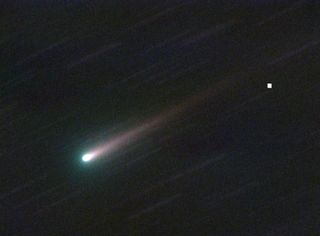Comets Are Like Deep Fried Ice Cream, Scientists Say

NASA researchers think they understand why comets have a hard, crispy outside and a cold but soft inside — just like fried ice cream.
Two NASA spacecraft have interacted with a comet surface, and both found a crunchy exterior and somewhat softer, more porous interior. Scientists know that comets are made of a mixture of rock and ice, but up until now they could not fully explain this change in texture from the inside to the outside.
Now, researchers using a souped-up refrigerator (officially known as a cryostat instrument) have re-created the conditions on the surface of a comet. They think they can explain the process that makes a comet not unlike a flying hunk of fried ice cream. [Amazing Comet Photos from Europe's Rosetta Probe]
Scientists suspect that the very coldest comets and icy moons in the solar system contain a special kind of ice called amorphous, or porous, ice. To create amorphous ice, water vapor molecules must be flash-frozen at a temperature of about minus 405 degrees Fahrenheit (243 degrees Celsius).
According to a statement from NASA, this flash-freezing process is "sort of like Han Solo in the Star Wars movie 'The Empire Strikes Back,'" — in the film, Solo is flash-frozen alive in a slab of carbonite.
Amorphous ice is extremely cold, but relatively soft, like cotton candy, according to Murthy Gudipati, a researcher at NASA's Jet Propulsion Laboratory and an author on the new study.
When the comet makes its way toward the sun, the temperatures on the outside become too hot for amorphous ice to survive. In the new study, the researchers re-created what happens on the comet's exterior when the temperature starts to rise.
Get the Space.com Newsletter
Breaking space news, the latest updates on rocket launches, skywatching events and more!

"The PAHs stuck together and were expelled from the ice host as it crystallized," Antti Lignell, a postdoctoral scholar at the California Institute of Technology in Pasadena and lead author in the new study, said in the statement. "This may be the first observation of molecules clustering together due to a phase transition of ice, and this certainly has many important consequences for the chemistry and physics of ice."
With the PAHs expelled, the now-purified ice was free to form a dense, crispy outer shell around the body of the comet. Inside, the ultracold, somewhat fluffy amorphous ice remains.
"Deep fried ice cream is really the perfect analogy, because the interior of the comets should still be very cold and contain the more porous, amorphous ice," said Gudipati.
The PAHs, meanwhile, come together to form a final layer on top of the crunchy outer shell, Gudipati said. "The organics are like a final layer of chocolate on top."
Follow Calla Cofield @callacofield. Follow us @Spacedotcom, Facebook and Google+. Original article on Space.com.
Join our Space Forums to keep talking space on the latest missions, night sky and more! And if you have a news tip, correction or comment, let us know at: community@space.com.

Calla Cofield joined Space.com's crew in October 2014. She enjoys writing about black holes, exploding stars, ripples in space-time, science in comic books, and all the mysteries of the cosmos. Prior to joining Space.com Calla worked as a freelance writer, with her work appearing in APS News, Symmetry magazine, Scientific American, Nature News, Physics World, and others. From 2010 to 2014 she was a producer for The Physics Central Podcast. Previously, Calla worked at the American Museum of Natural History in New York City (hands down the best office building ever) and SLAC National Accelerator Laboratory in California. Calla studied physics at the University of Massachusetts, Amherst and is originally from Sandy, Utah. In 2018, Calla left Space.com to join NASA's Jet Propulsion Laboratory media team where she oversees astronomy, physics, exoplanets and the Cold Atom Lab mission. She has been underground at three of the largest particle accelerators in the world and would really like to know what the heck dark matter is. Contact Calla via: E-Mail – Twitter